When online multiplayer was first conceived, it’s doubtful anyone truly predicted how wildly popular it would become. Beginning with PCs very early on and entering consoles around the sixth generation (the Xbox, PS2, and Dreamcast era), it seemed like many single-player titles had to have some kind of online multiplayer component. As time went on, largely solo titles like Assassin’s Creed and Tomb Raider received substantial online modes in addition to their offline content. Whether multiplayer felt tacked on in many of these titles is moot; the point is that everyone wanted a piece of the online cake.
While this is perfectly fine and, in most cases, great fun, a troubling trend is currently sweeping the video game industry: games that are played exclusively through online multiplayer. Titles like Overwatch and Fortnite aren’t popular because of their engrossing offline offerings — quite the contrary. These games are meant for online multiplayer and online multiplayer only. If you don’t have a stable internet connection or don’t have internet at all, you’re out of luck. If you would rather play couch multiplayer or with bots, you’re, once again, out of luck.
Obviously, online shooters aren’t the only games available in today’s day and age. With success stories like Super Mario Odyssey, The Legend of Zelda: Breath of the Wild, and Insomniac’s Spider-Man, it would be darn near silly to proclaim the “death of the single-player campaign”.
Still, it’s a bit concerning to see releases like Call of Duty: Blacks Ops 4 that heavily prioritize online gaming over on-disc, forever-available, offline content. Obviously, some titles are meant solely for multiplayer, and that’s okay. The problem lies in the cultural longevity of these experiences. One day, years from now, the servers will cease to exist. And so, too, will the game itself.
Take any game from the Nintendo 64 era and prior, and you’ll see that every bit of the content is still intact and ready to play straight from the cartridge or disc. Take online-enabled games from the PS2 age and beyond, however, and you’ll start to find some holes in your breadth of historical reference. Because I purchased Ratchet and Clank: Up Your Arsenal 14 years after its initial release, I’ll never, ever get to experience the online multiplayer as it was. The game still holds value, though, due to the rich offline content, even if that one feature has been lost to time.
Many modern games, on the other hand, will not be so lucky. Without a campaign, local multiplayer, LAN play, or even so much as a simple PVP mode, these online-only shooters will simply disappear once the developer decides it’s time to pull the plug. Current owners of these titles will be left with $60 paperweights, and future gamers will literally never get to experience any part of the fun — not even a fraction of it. Internet-based games are ticking time bombs that will someday be unavailable to play.
This is the unfortunate truth of online multiplayer.
We’ve already seen a few games die in recent years. In fact, this is incredibly common with Mmssively multiplayer online games (MMOs). Disney’s ToonTown Online was a popular children’s MMO that launched in 2003 and was discontinued in 2013. Two of Disney’s other MMOs, Pirates of the Caribbean Online (2007) and Pixie Hollow (2008) were also discontinued the same year. Since MMOs are never purchased and are instead paid for through subscription fees, they essentially become services that can discontinue at any time. Not all MMOs have long lifespans, either. Cartoon Network Universe: FusionFall was launched in 2009, only to be shut down in 2013. Sony’s Free Realms had a similar lifespan: 2009 to 2014.
Naturally, there are plenty of online titles that haven’t gone under yet, like Second Life. But that doesn’t mean every game/service can be so fortunate. While MMOs, as a concept, are meant to be ongoing services, it’s still quite sad to see these games completely vanish, outside of unofficial, fan-made continuations (like ToonTown Rewritten).
This problem is not limited to the PC side of things, either. Dust 514, a free-to-play first-person shooter, was released on the PlayStation 3 in 2013. After struggling to maintain a large playerbase, it shut down just three years later in 2016. Another, much more controversial example of this is none other than the battle royale title The Culling 2. Released on July 10th, 2018 for Windows, PlayStation 4, and Xbox One during the explosion of the battle royale genre, The Culling 2 was criticized for appearing unfinished. The game reached peak Steam player counts of about 250 on its first day. On July 18th, 2018, The Culling 2 was pulled from digital storefronts and discontinued entirely. While it’s doubtful anyone is clamoring for The Culling 2 to return, this is literally a dead game. It simply does not exist anymore. This is a problem.
Contrast this with Phantasy Star Online, an online role-playing game released in 2000 for the Sega Dreamcast. Though it was plenty popular, the online portion was shut down in 2003. Fortunately, the game features a single-player mode that keeps the content alive in some fashion. Additionally, a small group of fans have built unofficial servers so that even the online portion can exist to this day. Keep in mind, however, that not every title has the luxury of a dedicated community. Not every online-enabled game will survive the test of time.
By no means do I advocate for the death of these services. Playing with friends and strangers through the internet is loads of fun, and there isn’t the slightest chance of anyone giving up on it when it’s already deeply ingrained into the gaming consciousness. What I’m rallying for is, quite simply, more. We, as gamers, should want games that last forever — games that can be bought used 20 years from now and still function in some capacity.
One of the best examples of this in recent memory is Splatoon. Although the online multiplayer is a huge draw, it’s definitely not the only draw. On the fateful day that Turf War goes away, we’ll still have a sizable singe-player mode, Amiibo bonus missions, and a two-player battle mode readily available off the disc. Splatoon — like Phantasy Star Online — will always exist in some capacity. A fairly substantial capacity, if you ask me.

Admittedly, not every game can do what Splatoon does. The age-old single-player story mode doesn’t always fit within a predominately multiplayer framework. So, with that in mind, why don’t developers take a more “old-fashioned” approach to the problem?
Underappreciated as it is, local multiplayer is an excellent solution for preserving the fun once the servers all shut down. And for genres where all players can easily be viewed on one screen — such as sports, fighters, and platformers — it’s almost a given. However, in games that require splitscreen, we’ve seen quite a bit of resistance from developers.
Whether cooperative or competitive, the excuse is always the same: it’s too difficult to make splitscreen work with modern console hardware. Studios state that games have become far too visually demanding; that the labor required to run splitscreen is too intensive; that players would have to deal with major sacrifices to graphics and framerate.
In a 2016 thread on Blizzard Entertainment’s Overwatch forums, Game Director Jeff Kaplan expained that “Splitscreen is very challenging from a technical perspective.” He added, “Although it’s very unlikely we would be adding that feature, we’re not philosophically opposed to it. I know this isn’t the answer you want to hear…it’s just really, really hard.”
Similarly, in a developer post on Halo Waypoint, the following was stated about the removal of splitscreen: “Our decision was driven by a desire for scale, fidelity and focus to ensure that we would deliver the best quality experience possible. With Halo 5 we are delivering massive scale environments, improved AI behavior, increased visual and gameplay fidelity… something that truly takes advantage of a new platform. Many of our ambitious goals for Halo 5 would be compromised in a split-screen setting and the time spent optimizing and addressing split-screen-specific issues would take focus from building other parts of the game. Game development is a balancing act of resources, time and technology, and in this case we made the tough decision to sacrifice something that’s been near and dear to us all.”
Developers are increasingly leery of the work that goes into local multiplayer. But splitscreen has always required labor and sacrifices. Now, with our massive HD television sets, it seems almost unfair to deny any kind of offline play.
The gaming community should push for more offline content, even if it’s not a campaign. No matter what the reduction in graphical fidelity or performance may be, we should expect some approximation of the online gameplay. And if splitscreen truly is impossible, we should expect some kind of offline LAN mode. What we should expect is longevity.
At this point, it seems almost laughable to suggest that the battle royale mode in Fortnite would ever go dark. But at their peaks, it was probably laughable to suggest the same thing about games like ToonTown, as well. We can never predict when or if a game will shut down, but we never want it to stop existing. The most dedicated fans will always find ways to preserve their favorite games — hence why unofficial Dreamcast servers exist in 2018 — but what about games that fall through the cracks? Every game deserves preservation, and offline functionality can always guarantee this in some small way.
As I’ve said multiple times already, those servers will dissolve. And when that happens, we don’t want to lose any of the gameplay.
Some of the coverage you find on Cultured Vultures contains affiliate links, which provide us with small commissions based on purchases made from visiting our site.




